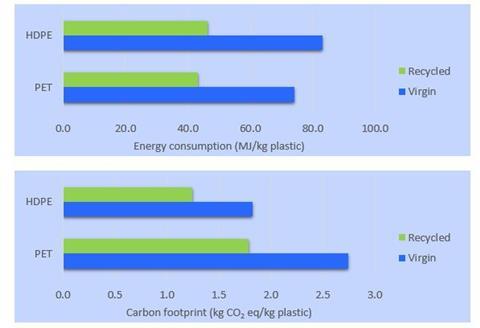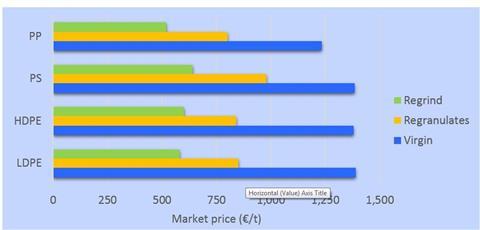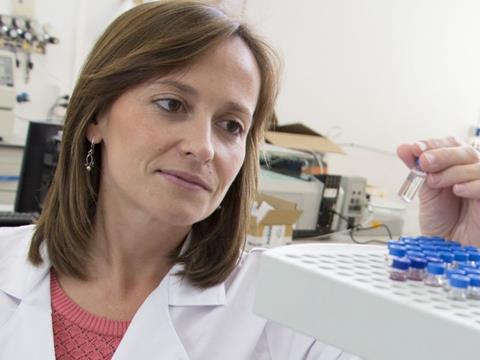
This paper reviews the current situation of recycled plastic materials in food contact applications, showing the different opportunities currently available to use recycled plastics as food contact materials.
The paper further focuses on explaining in more detail one of these possibilities, namely the incorporation of recycled plastics behind a functional barrier. Finally, some of the latest developments in the field of functional barriers for the use of recycled materials in multi-layer food packaging are presented.
by Enrique Moliner, Eva Verdejo, Department of Sustainability & Industrial Recovery - AIMPLAS (Plastics Technology Centre)
Introduction
Packaging is by far the industrial sector with the largest consumption of plastics with about 40% of total European plastics demand (PlasticsEurope, 2016). The commercial success of plastic materials in packaging applications is due to their excellent versatility, as a result of the combination of their various properties: flexibility, strength, lightness, transparency, stability, impermeability, and so forth. This versatility has led plastics to become essential materials for the manufacture of all types of packaging, both rigid and flexible, for numerous commercial and industrial applications, including food packaging.
The advantages of plastics for packaging applications are not only limited to their versatility and technical performance, but they can also contribute to improve the sustainability of packaging. Plastic materials allow to reduce the weight of packaging, leading to a reduction of the environmental and economic costs from transport. Light packaging also enables to reduce the amount of waste generated, thus minimizing the environmental impacts of waste management and treatment. Moreover, the use of plastics in food packaging can improve the barrier properties against gases and moisture, thus protecting and preserving foodstuffs for longer periods, so they can also contribute to reduce food and packaging wastes.
However, the end of life of plastic products in general, and packaging in particular, is probably their most controversial aspect today, since once they reach the end of their useful life, they usually become waste and are not always managed in the best way possible. In 2014, about 26 million tonnes of post-consumer plastics waste were generated in the EU. Only 29.7% of these plastics were recycled, 39.5% were incinerated with energy recovery, while the remaining 30.8% of post-consumer plastics waste still went to landfill (PlasticsEurope, 2016), representing a huge waste of resources and being still far from the objectives of the latest environmental policies.
The reasons for boosting plastics recycling are several, including legal, environmental and economic factors. The new circular economy model that is being promoted in the EU establishes that all waste must be converted again into resources to be returned to the production system in a cyclical way (European Commission, 2014). This circular model is aimed at reaching a very ambitious objective of zero waste to landfill. Therefore, efforts are still required in most EU countries to reach zero plastics to landfill, giving priority to plastics recycling over energy recovery since recycling is the preferred option in environmental terms according to the waste management hierarchy.
For most plastic materials the difference in energy intensity between virgin and recycled sources can be very large, which translates into a significantly reduced carbon footprint of recycled plastics. Hence, by using recycled plastic materials, companies can help to reduce the carbon intensity of new products while also reducing emissions from landfill or incineration. Furthermore, companies can obtain economic benefits by using recycled plastics, since these typically have a lower market price than their equivalent virgin ones. Thus, important reductions in purchasing costs can be achieved by replacing virgin plastics with recycled plastics, which can range between 30% and 60% depending on the plastic material and the type of recyclate; a plastic regrind is much cheaper than a plastic regranulate.


Even though the trend over the last decade shows a significant reduction in the amount of plastic packaging sent to landfill, it is necessary to continue investing efforts to increase recycling rates and move towards the zero waste target in the EU. Efforts should focus on the following key issues:
• Development and optimization of recycling processes to improve the quality of the resulting recycled plastics, including sorting, separation and decontamination technologies to remove odours and critical substances in post-consumer plastic packaging waste
• Search for new applications for recycled plastics, which allow to expand the market for these materials.
The use of recycled plastics in food packaging is a novel application with enormous potential, especially considering that about 40% of the plastics consumed in Europe are used in packaging (PlasticsEurope, 2016), with food packaging accounting for 70% of the plastic packaging market (AMI, 2008).
Recycled plastics in contact with food
Food safety is the main driver for the development and implementation of regulations on food contact materials. Hence, the legal framework at the European level is defined on the basis of the scientific work done by the European Food Safety Authority (EFSA), which is the agency of the EU that provides independent scientific advice and support on food safety issues to the European Commission, the European Parliament and EU member states.
At the EU level, food contact materials are regulated under Regulation (EC) No 1935/2004 (European Commission, 2004), which is commonly referred to as the ‘Framework Regulation’ and covers all food contact materials, including those for packaging, machinery and kitchenware. According to the Framework Regulation, no food contact materials shall transfer constituents into food at levels that endanger human health or produce unacceptable changes in food composition or organoleptic properties. This Regulation establishes the authorisation procedure for substances used in food contact materials, with the EFSA assessing the applications submitted for authorisation purposes. It also deals with other key aspects such as the requirements related to labelling, traceability systems (at all stages of production and distribution) and declarations of compliance for food contact materials and articles. Moreover, the Framework Regulation is supported by Regulation (EC) No 2023/2006 (European Commission, 2006) on Good Manufacturing Practices, which establishes the requirements for quality assurance and control systems allowing to ensure compliance with the Framework Regulation.
The Framework Regulation also mandates the establishment of further specific requirements for individual food contact materials. Some of this requirements have already been adopted through specific regulations for specific materials, including plastics and recycled plastics, among others. Regulation (EU) No 10/2011 (European Commission, 2011) and its amendments establish specific requirements for plastic materials and articles intended to come into contact with food. This Regulation addresses both mono- and multi-layer plastic articles. It provides the positive list of monomers and additives that can be used in plastic food contact materials. It also defines the basic rules on overall and specific migration testing for final materials or products, including testing requirements and migration limits.
It should be noted that plastics depolymerized into monomers or oligomers have to meet the same requirements as virgin plastic materials under Regulation (EU) No 10/2011, while plastics mechanically recycled must also comply with these and other additional requirements. There are three possibilities to use mechanically recycled plastics in contact with food:
• The first one is to use offcuts and scraps from the production of plastic food contact materials that have not been in contact with food yet. These can be recycled within the manufacturing site where they are generated or, alternatively, at another site where an audited quality assurance system is in place and meets the requirements laid down in Regulation (EC) No 2023/2006. Traceability is critical in this case to verify the source of the materials and ensure that they are not affected by any kind of pollution. Offcuts and scraps are post-industrial waste (or pre-consumer), which are typically recycled within the same manufacturing site that generates them due to their high quality as waste: they usually have a controlled and homogeneous composition and are clean waste with almost no degradation. Hence, there is very limited availability of this kind of plastics in the market for secondary raw materials, but other alternatives are available like post-consumer recycled plastics.
• The second possibility is to use post-consumer recycled plastics from processes authorised by EFSA according to Regulation (EC) No 282/2008 (European Commission, 2008). In this case, the recycled plastics must be produced from waste coming from food contact materials. Traceability is therefore critical to verify the waste source and ensure the avoidance of waste contamination through a controlled closed-loop system. If a closed loop is not possible, a ‘challenge test’ must be performed to demonstrate scientifically that the recycling process is able to reduce any contamination of the plastic waste in a way that food safety risks are totally avoided. EFSA is responsible for the risk assessment of the recycling process and, taking into account its opinion, the European Commission will adopt a decision granting or refusing the authorisation. Authorised recycling processes will be included in a register published on the Commission website. At present, there are several processes with positive scientific opinions from EFSA, most of them for recycling of polyethylene terephthalate (PET), but the authorisations by the European Commission are delayed. Hence, there is no a list of authorised processes published yet, but recycled plastics from processes with positive opinion from EFSA can be used for food contact applications in the meantime in some EU member states according to their national transitional provisions.
• The third possibility is to use recycled plastics behind a functional barrier, as specified in Regulation (EU) No 10/2011, which will be the focus of the paper hereafter.
Functional barriers
A functional barrier is a layer or multi-layer within food contact materials or articles which prevents the migration of substances from behind that barrier into the food. Functional barriers can thus be used to incorporate recycled plastics into food contact articles like multi-layer food packaging. In this case, the recycled plastic is not in direct contact with food but separated by the functional barrier, which avoids the transfer of non-authorised substances from the recycled layer to the foodstuff. Symmetrical multi-layer structures with functional barriers at both sides of the recycled layer can also be developed to avoid set-off migration effects during the storage of stackable packaging. Set-off migration involves the transfer of substances through the non-food contact side of the packaging to the food contact side of other packaging when stacking of packaging items like cups or trays.

Behind a functional barrier, non-authorised substances may be used, provided they fulfil certain criteria and their migration remains below a given detection limit: a maximum level of 0.01 mg/kg in food is established for the migration of a non-authorised substance through a functional barrier. Unlike the case of recycled plastics from authorised processes, functional barriers allow to use post-consumer recycled plastics from waste originated from non-food contact applications. There are only a few substances that are not covered by the functional barrier concept. These include substances that are mutagenic, carcinogenic or toxic to reproduction, as well as nanoparticles.
The effectiveness of the functional barrier to protect food from migration depends on several parameters, including:
• Concentration and diffusion coefficient of contaminants in the recycled layer.
• Chemical nature and thickness of the barrier layer.
• Conditions of use, including the type of food packaged and the temperature and time of use.
Thus, we can distinguish between absolute and partial barriers. Some materials, such as glass (any thickness) or certain metals (e.g., aluminium foil ≥ 8 µm thickness), are able to ensure complete blockage of migration. Plastic materials, however, are partial barriers that may reduce the migration of substances below specific migration limits. This is the case of virgin PET, which is the plastic most investigated as functional barrier. According to scientific studies by the US Food & Drug Administration (FDA, 2006), 25 microns of virgin PET can be used as functional barrier for a recycled plastic inner layer under conditions of use at room temperature and below, while for higher temperatures the thickness of virgin PET required is at least 50 microns, provided that only food packaging waste is used to manufacture the recycled layer.
Therefore, while in some cases the use of certain functional barriers in the development of multi-layer packaging will make it obvious that migration of substances into food is not possible under the conditions of use, in many other applications not tested before the effectiveness of the functional barrier must be demonstrated case by case through scientific studies. The following procedure can be followed to demonstrate that a given thickness of a virgin polymer works as an effective barrier to the migration of contaminants:
1) Intentional contamination of a virgin polymer with a known concentration of surrogate substances (i.e., a challenge test), which is used to simulate a recycled plastic in the worst scenario possible in terms of contamination.
2) Incorporation of the contaminated polymer as an inner layer into the final article, using a virgin polymer with a given thickness as the barrier layer.
3) Migration testing with food-simulating solvents under worst foreseeable conditions of use to determine if the virgin polymer and thickness used for the barrier layer are effective enough to avoid the migration from the contaminated polymer.
The Joint Research Centre of the European Commission (JRC, 2016) has recently published a draft of technical guidelines with very interesting results about functional barriers based on mathematical migration modelling and experimental studies. It provides thickness values for functional barriers made of various polymers through which no migration is expected at different time-temperature conditions for different molecular mass ranges of migrants (Table 1). It also defines several flexible packaging film structures that could be used as general functional barriers under certain conditions of use (Table 2). It should be noted that besides the barrier properties achieved only with a mono-layer virgin polymer, other very thin barrier layers can be placed on packaging polymers to achieve excellent barrier effects by the whole multi-layer structure; e.g., Silicon oxide (SiOx) or ethylene vinyl alcohol (EVOH), among others.
The BANUS Project
BANUS is a European project coordinated by AIMPLAS, the Plastics Technology Centre, and funded by the European Commission under the Seventh Framework Programme. The project was aimed at developing new multi-layer structures that enable the use of recycled materials behind functional barriers to be used in food packaging applications.
Three different types of multi-layer structures were developed for different food packaging products. The first one was a semi-rigid multi-layer plastic tray produced by co-extrusion (and thermoforming). This is a commercial tray that was initially made of virgin polypropylene (PP) and EVOH, but it was redesigned in the project to incorporate recycled PP (rPP) behind a functional barrier of virgin PP. The second development was a flexible multi-layer multi-material packaging produced by lamination. In this case, virgin polyethylene (PE) was used as a functional barrier to enable the incorporation of recycled paper (rPaper) in the new packaging. The third development was a coated paperboard burger box in which the coating itself was used as functional barrier for recycled paperboard (rPB). The replacement of a percentage of virgin materials with recycled post-consumer materials, including plastic, paper and cardboard, led to more cost-effective and environmentally friendly food packaging products.
One important finding in the BANUS Project was the detection of diffusion effects in some production processes; e.g., during co-extrusion the temperature is very high and non-authorised substances from the different layers may diffuse into the functional barrier layer. For this reason, functional barriers must be carefully investigated and scientifically validated, trying to minimize diffusion effects. It should be noted that this diffusion does not appear in other processes like lamination or coating.

Conclusions
The use of recycled plastics can bring competitive advantages to food packaging producers other than the improved environmental performance of their products, such as cost savings, improvement of corporate image, green marketing and access to new markets, encouragement of eco-innovation and preparation for future environmental regulations. There are three different possibilities available for manufacturers to incorporate mechanically recycled plastics in food packaging: (1) use of offcuts and scraps from the production of plastic food contact materials (i.e., pre-consumer waste), (2) use of recycled plastics from processes authorised by EFSA, and (3) use of recycled plastics behind a functional barrier. The use of functional barriers is the only option allowing to use recycled post-consumer plastics from waste with non-food contact origin. To this end, the effectiveness of the functional barriers to prevent migration of substances into the food must be scientifically demonstrated on a case-by-case basis, since it can depend on many factors that may significantly vary from one case to another.
More info:
















